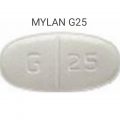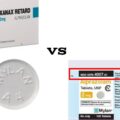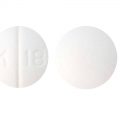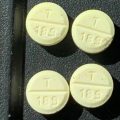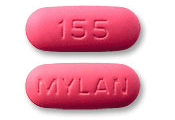
The pink oval pill with the imprint 155 MYLAN has been identified as Acetaminophen and Propoxyphene Napsylate 650 mg / 100 mg supplied by Mylan Pharmaceuticals Inc. Acetaminophen/propoxyphene is used in the treatment of pain and belongs to the drug class narcotic analgesic combinations.
Mylan 155 (propoxyphene napsylate and acetaminophen) is intended for the management of mild to moderate pain. The dose should be individually adjusted according to the severity of pain, patient response, and patient size. The usual dosage is one tablet every 4 hours orally as needed for pain. The maximum dose of Mylan 155 is 6 tablets per day. Do not exceed the maximum daily dose.
Patients receiving propoxyphene and any CYP3A4 inhibitor should be carefully monitored for an extended period of time and dosage adjustments should be made if warranted. Consideration should be given to a reduced total daily dosage in elderly patients and in patients with hepatic or renal impairment.
Can Mylan 155 Get You High?
Yes. The propoxyphene component of Mylan 155 can produce drug dependence of the morphine type, and therefore, has the potential for being abused. Psychic dependence, physical dependence, and tolerance may develop upon repeated administration. This explains why Acetaminophen/propoxyphene 650 mg / 100 mg is classified as a Schedule 4 controlled substance under the Controlled Substance Act (CSA).
Schedule 4 drugs and substances have a low potential for abuse relative to those in Schedule III. The drug or substance has a currently accepted medical use in treatment in the United States. Abuse of the drug or other substance may lead to limited physical dependence or psychological dependence relative to the drugs or other substances in Schedule III.
Since Mylan 155 is a mu-opioid agonist, it may be subject to misuse, abuse, and addiction. Addiction to opioids prescribed for pain management has not been estimated. However, requests for opioids from opioid-addicted patients occur. For patients who used Mylan 155 on a regular basis for a period of time, when therapy with Mylan 155 is no longer needed for the treatment of their pain, it may be useful to gradually discontinue the Mylan 155 (propoxyphene napsylate and acetaminophen) over time to prevent the development of an opioid abstinence syndrome (narcotic withdrawal).
In general, therapy can be decreased by 25% to 50% per day with careful monitoring for signs and symptoms of withdrawal. If the patient develops these signs or symptoms, the dose can be raised to the previous level and titrated down more slowly, either by increasing the interval between decreases, decreasing the amount of change in dose, or both.
Conclusion
The drugs that may be addictive target your brain’s reward system. They flood your brain with a chemical called dopamine. This triggers a feeling of intense pleasure. You keep taking the drug to chase that high. Propoxyphene works by binding to the opioid receptors in the brain. This is what gives Opioids their pain-relieving quality. In addition, Propoxyphene, much like Codeine, worked as a cough suppressant. It seemed perfect; a weaker alternative to Codeine that could just be prescribed for a cough then weaned off more easily than other Opioids. The dangers of Opioid addiction, however, are always present. Over time, your brain gets used to the extra dopamine. So you might need to take more of the drug to get the same good feeling. And other things you enjoyed, like food and hanging out with family, may give you less pleasure. ALSO SEE: MYLAN A4


